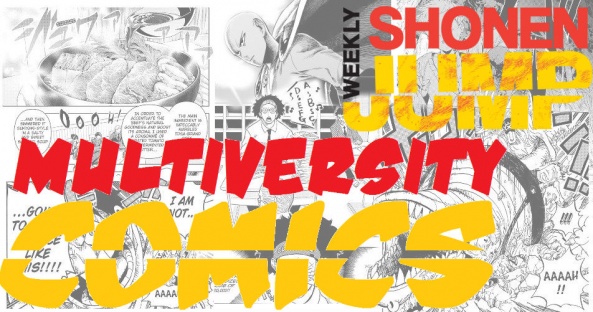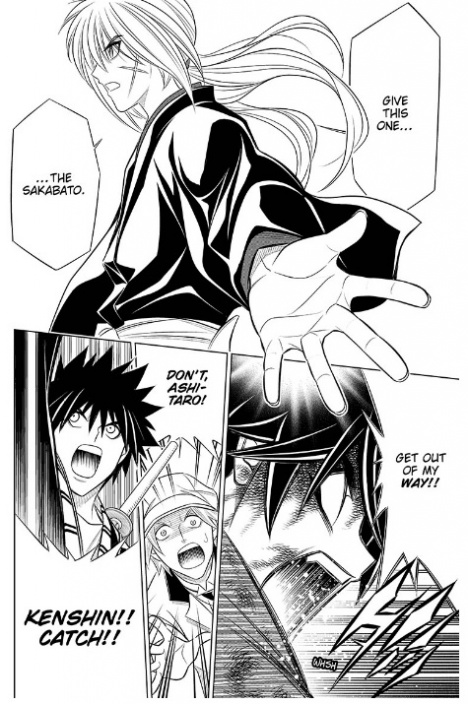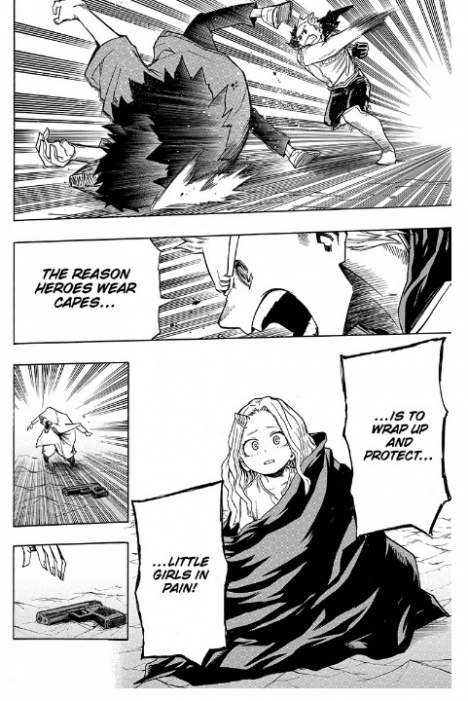
Welcome to This Week in Shonen Jump, in which a rotating duo of Multiversity staffers take a look at two stories contained in each installment of Viz Media’s Weekly Shonen Jump. For the uninitiated, Weekly Shonen Jump is an anthology that delivers more than 200 pages of manga of all varieties. We hope that you’ll join us in exploring the world of Weekly Shonen Jump each week. If you are unfamiliar, you can read sample chapters and subscribe at Viz.com.

This week, Robbie and Ken check in with “My Hero Academia” and “Rurouni Kenshin.” If you have any thoughts on these titles, or “Food Wars,” “Hunter x Hunter,” “Robot x Laserbeam,” “One Piece,” “Seraph of the End,” “Black Clover,” “Dr. Stone,” “The Promised Neverland,” or “We Never Learn,” let us know in the comments!

Rurouni Kenshin: The Hokkaido Arc Ch. 1
Written & Illustrated by Nobuhiro Watsuki
Story Consultant: Kaworu Kurosaki
Review by Ken Godberson III
“Rurouni Kenshin” was a shonen anime/manga that was part of my childhood. In middle school, all my friends were into “Dragonball Z” but I found much more appeal in Himura Kenshin over Son Goku. It was a tale of redemption, the changing tides of history and how you have to change with it, finding empathy for those less fortunate all while having some great battles. The Kyoto Arc is the stand out, being one of the most well-constructed arcs in any anime. So hearing that Nobuhiro Watsuki (along with his wife and novelist Kaworu Kurosaki) were bringing the series back to tell a new tale after nearly two decades I was excited, if nervous.
However, after reading the first chapter of “The Hokkaido Arc”, I can safely say that I was worried over nothing.
This first chapter takes place in Year of the Meji 16, five years after the conclusion of the series. It’s very much a “welcome back” and introduction to the denizens of the Kamiya Kashin Dojo, all narrated by it’s master, Kaoru Kamiya-Himura. We see little Kenji, who is adorable (and not a brat who hates his father, but that’s enough about Reflections) and we see Yahiko Myojin, now grown into a young man and assistant instructor of the busy dojo and of course, the man himself: Himura the Battousai.
We are also introduced to three new characters (or re-introduced in some cases, from the two part prologue story back in late 2016): Inoue Aran, an illegitimate child who lives at the dojo as a student, a mysterious young girl named Asahi, and the return of Hasegawa Ashitaro, another student at the Kamiya Dojo, but who had been a criminal and remnant of the army created by Shishio Makoto, Kenshin’s successor, villain of the Kyoto Arc and all around best villain of the series. Like I said, this issue was a lot of introductions, especially for these three as we see Inoue’s craftiness, Asahi’s strong spirit, and Ashitaro… well I’ll talk about him in a bit.
Now, how does Hokkaido, Japan’s northernmost prefecture, factor into this? Well, that was actually one of my favorite parts: the catalyst for the trip to Hokkaido. I won’t fully spoil what it is, but I’ll say this: It doesn’t have to do with Kenshin or his past. It has to do with Kaoru’s past and I think that’s great. I’ve always loved Kaoru; in the list of favorite female anime/manga characters, she’s up there. However, it felt like she got shafted sometimes (looking at you, Jinchuu Arc) so having her story be the reason to go to Hokkaido I felt was a lot stronger than another thing from Kenshin’s past.
Now onto the artwork, which has not missed a beat. Watsuki has become a bit sleeker with his drawings over time, angular in some ways, helping to create good flow. There are two techniques that stick out for me: first his use of negative space. This is greatly exemplified after Ashitaro uses a certain sword technique (more on this when I talk about him) and the use of negative space to display his rage. The other technique is something I really have only seen in Watsuki’s fight scenes: a kind of ink blotting in page spreads to display a force of an attack. It’s not representing blood, Kenshin’s sakabato doesn’t cut, but it’s an interesting technique to really sell home the strength of Kenshin’s attack. Lastly, the two page collage of the various moments from the series, culminating in a happy Kenshin, Kaoru & Kenji was, yes fanservice, but a wonderfully constructed bit for characters who really deserved (and not die of leprosy and Oh God, I’m thinking about Reflections again).
Continued belowAs for the big downside: Let’s talk about Ashitaro. I don’t hate the character but he does come off as a bit… “bad boy Shonen character”. Gruff, reserved, rude but also a bit of a hothead. On top of being a remnant of Shishio’s faction -tying him into the previous series- he also has the Mugenjin, Shishio’s sword. It’s too early to tell, and there is some hints to growth (the emphasis on his inability to read and how not good that is), but i feel it Watsuki is going to have to walk a fine line to prevent him from falling into some annoying stereotypes that have happened in shonen.
All in all, if you were a fan of “Rurouni Kenshin,” you’re going to dig this. If you’ve never read the series, then give this a shot. It can be a bit dialogue heavy, but it does get you up to speed with the world.
Final Verdict: 7.3- A fun trip for the nostalgic and a good introduction for newcomers.

My Hero Academia chapter 151
Written and illustrated by Kohei Horikoshi
Reviewed by Robbie Pleasant
It’s Mirio versus Overhaul, as the raid on the Shie Hassaikai Group continues, and the intensity of the arc shows no signs of diminishing. We’ve already seen some impressive fights and character moments leading up to this, but any boss fight deserves to be a special level of epic, and that is what Kohei Horikoshi is giving us.
The chapter features an excellent blend of action and emotion, perfectly mixed for maximum effectiveness. We weep for Eri and hate Overhaul when he tells her “you were born to break people.” We cheer for Mirio as he fights to defend her. There are some fittingly heroic moments, including a wonderful use of the classic hero cape that would make even Edna Mode approve.
Yet one thing that makes “My Hero Academia” stand out from other shonen series is the amount of attention it gives its villains as well as its heroes. A common theme throughout these chapters has been how the villains have bonds of trust and camaraderie just as strong as the heroes, along with their own backstories that provide their motivations. We get little glimpses into the foes Mirio is fighting, and we understand them better even though they’re the “bad guys.” While other series may just say “they’re evil, they’re selfish, what else do you need to know?” “My Hero Academia” defies the cliche and gives us well-rounded characters even in our antagonists.
All the while, Horikoshi continues to give us very solid artwork. The manga builds tension nicely by giving us close-ups on the characters, seeing the expressions on their faces. The details, shading, and action lines all add to every moment, and each panel is filled with such intense emotion.
When the action begins, nothing is held back. There’s an amazing single-page panel showing off Overhaul’s power, as the room shatters around him. The following two-page spread is intense and powerful as we see Mirio fight to save Eri, and the deadly potential of Overhaul’s power is displayed.
Outside of the action, though, the true strength of the art is in the characters’ expressions. Just take a gander at the intense look on Mirio’s face as Overhaul reveals how truly abusive he is to Eri, or Eri’s expression as Mirio defends her. Every expression adds to the intensity and sheer emotion of the manga, which has made it so endearing to readers.
Yet while this is the epic showdown of hero versus villain leader, Mirio isn’t even the main characters. In any other manga, that would mean he gets defeated to show off the villain’s strength before the protagonist can come in and win, but in “My Hero Academia” there’s no guarantee. Mirio is the more experienced hero, and his powers counter Overhaul’s perfectly, so there’s a real sense that he could win, while at the same time his enemies do present a legitimate threat, and having to protect Eri puts him at a handicap. Above all else, though, in the short time we’ve gotten to know Mirio in, we as readers are completely behind him and rooting for him. It doesn’t matter if he’s not the main character, he’s still a hero nonetheless, and we want to see him triumph over evil. With every heroic moment he grows on the readers more and more, endearing him to us as well as any main character would. No one knows how this fight will end, but it’s been an insanely satisfying battle through and through.
Final Verdict: 9.2 – “My Hero Academia” continues to be one of the strongest series in Shonen Jump, thanks to its excellent character work, artwork, story flow, and just about everything else. The chapter is intense in emotion and action, and if you’re not reading this manga yet, you need to get on it immediately.






